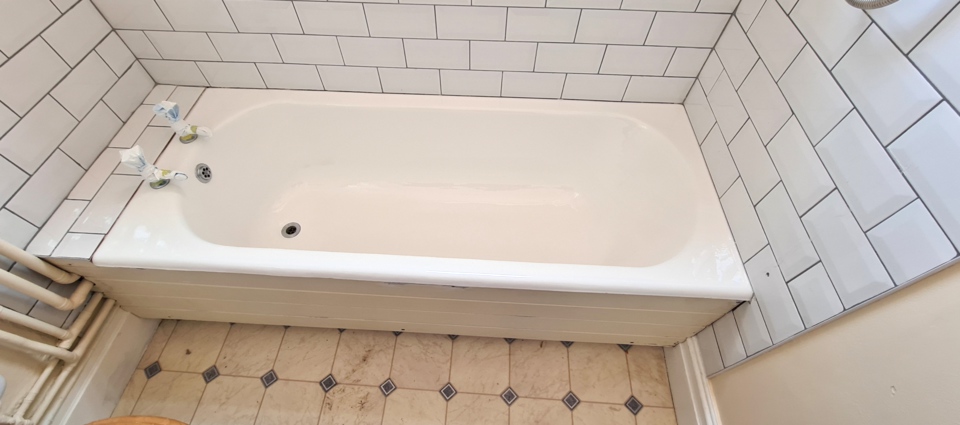
Our Process...
"Bath coating", "Bath resurfacing", "Bath restoration", "Bath re-enameling in situ". All these phrases and many more have the same meaning. the application of a chemically cured coating covering the inner surface of your bath.
We use several different processes for many different styles and constructions of bath.
Here we show our most common process.
To prepare and coat a white cast-iron moderately worn and stained boxed in style bath to white in situ.
-
Please note we can not perform a successful coating in building site conditions. or with the taps and shower dripping, -
Room preparation...We ask that before we arrive all personal items toiletries towels etc are removed. The shower screen if fitted will also need to be removed. If you are unable to do this yourself you may request that we remove it for you. (We cannot be held responsible for any damage that may be caused, as sometimes these items have been in place for many years and can be difficult to remove.) Dust sheets are laid. Furniture that cant be removed is covered and all other movable items are removed from the bathroom. Finally an extractor fan is installed and the door sealed.
- On arrival we perform a site survey... Before any work can be carried out the bathroom and surrounding areas are assessed. We will discuss the condition of the sealant weather it needs to be removed or cut back.
- We require a power point and a 10 inch window (that opens) for dust/fume extraction within 10 metres but not over the bath.
-
It’s all in the preparation... The bath is thoroughly cleaned and dried. Silicone sealant is removed or cut back as necessary.
-
Masking up...The area surrounding the bath is masked along with the taps waste and overflow (if fitted) as well as any furnishings that couldn’t be removed.
-
If you are planing to replace your taps, waste or overflow we recomend that they be removed prior to coating and replaced no less than 24 hours after completion.
-
The room is then thoroughly blown out using warm compressed air to prevent dust and debris falling on the surface during the spraying and curing process.
-
At this point rust is treated and chips/deep scoring is filled using a 3 part epoxy filler.
-
Bonding process........ A thorough application of our unique bonding agent is applied. This has been formulated specifically to enable our material to adhere to the existing surface. The bond is such that if you were to damage or chip your bath the water will be far less able to penetrate between the surfaces therefore greatly reducing the risk of de-lamination.
-
Surface application.... The coating (Poly-Glass a purpose made two pack enamel) is applied. Usually 3 to 4 coats using a warm H V L P (high volume low pressure) spray system specifically designed for indoor use. Our material is designed to withstand very high temperatures as well as be resistant to many of the chemicals in modern cleaner's. It also complies with current C.O.S.H. (Control Of Substances Hazardous To Health) and E.P.A (Enviromental Protection Act) regulations.
-
De masking... It is necessary to leave the paper surrounding the bath to continue acting as a dust barrier during the curing process. We also leave the taps masked to prevent any water dripping on the fresh surface. The remainder of the room is cleared .
Now it’s down to you...
Allow 24 hours un-wrap, apply sealant (where nesecary), Fill bath,lie back and....... ENJOY !!
At the other end of our spectrum,
To prepare and coat a particularly porous roll top style bath.
If previously re-finished the inner surface and roll is chemically stripped back to the original vitreous enamel .
The surface is then thoroughly cleaned and dried
Damage is filled and reshaped. Chips and cracks are repaired and the surface is made sound.
The surface is then primed and cured for 12 hours, then flatted to a smooth surface.
It's time to apply the coating. We use Poly-glass, a purpose made 2 pack enamel produced by NAPCO ltd . Several concessions of coats are applied to obtain the recomended film build.
After curing for a further 24 hours the surface is then machine polished to produce a smooth durable surface.
This process takes 10 to 12 hours over a 2 or 3 day period.
Please Note: We Don't use Vitreous Enamel
Neither do we use car paint
Our prefered products are supplied by NAPCO Ltd
Over the past 30+ years the following products of choice have in my opinion proved themselves to be amongst the best in the industry .
Mega-Fast Poly-Glass®
NAPCO’s proprietary aliphatic acrylic polyurethane provides amazing resilience
to cracking during expansion and contraction due to temperature fluctuations.
Unlike epoxy topcoats, Poly-Glass will not crack or yellow over time.
Poly-Glass resin provides a surface that is harder than acrylic or enamel,
yet flexible enough to withstand the impact of dropped objects.
This resilience is essential to its durability and long wear.
It also provides terrific stain resistance and colour retention, as compared to other types of bathtub coatings.
Gorilla Grip™ Wipe on Primer
Gorilla Grip was developed by NAPCO's chemist exclusively for use in
our industry and with over a year in the lab and over a 1,000 tubs
tested in the field,
Gorilla Grip has passed all tests with flying colours and has quickly
proven to be one of NAPCO's most popular products.
NAPCO Gorilla Grip is designed for priming bathtubs and tiles without etching or sanding. It's the perfect primer for these types of surfaces:
Ceramic
Fiberglass
Acrylic
Vitroeus Enamel

















